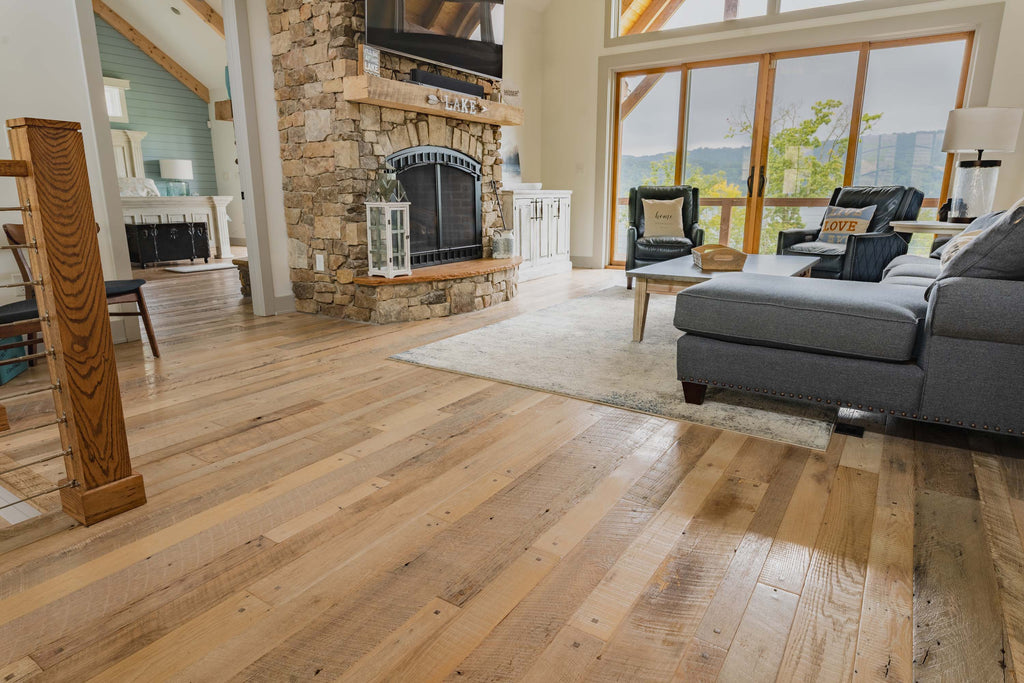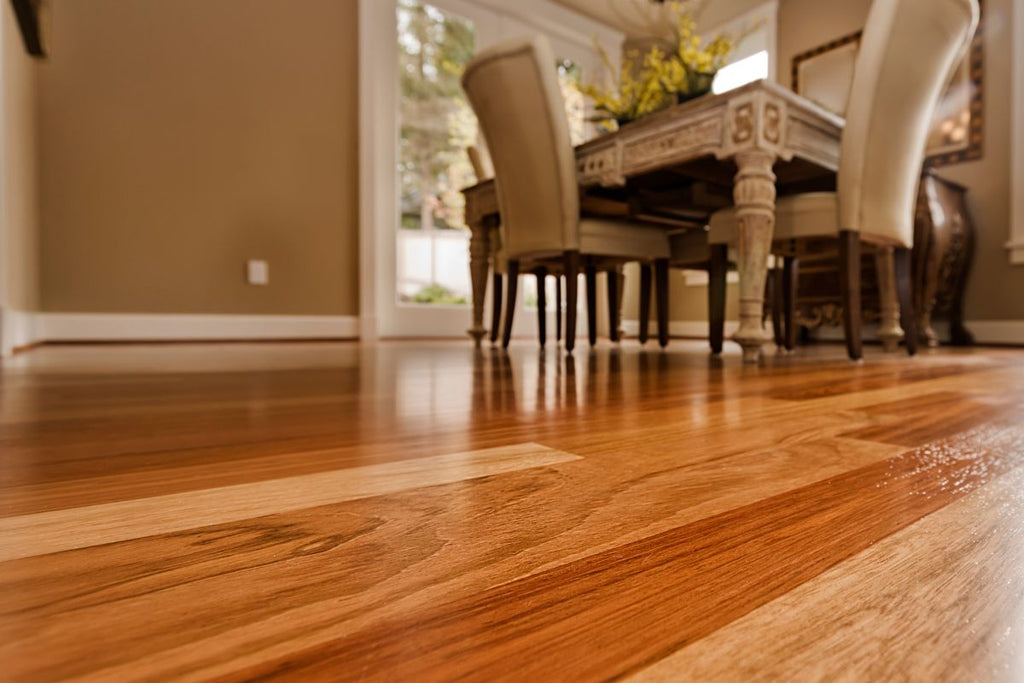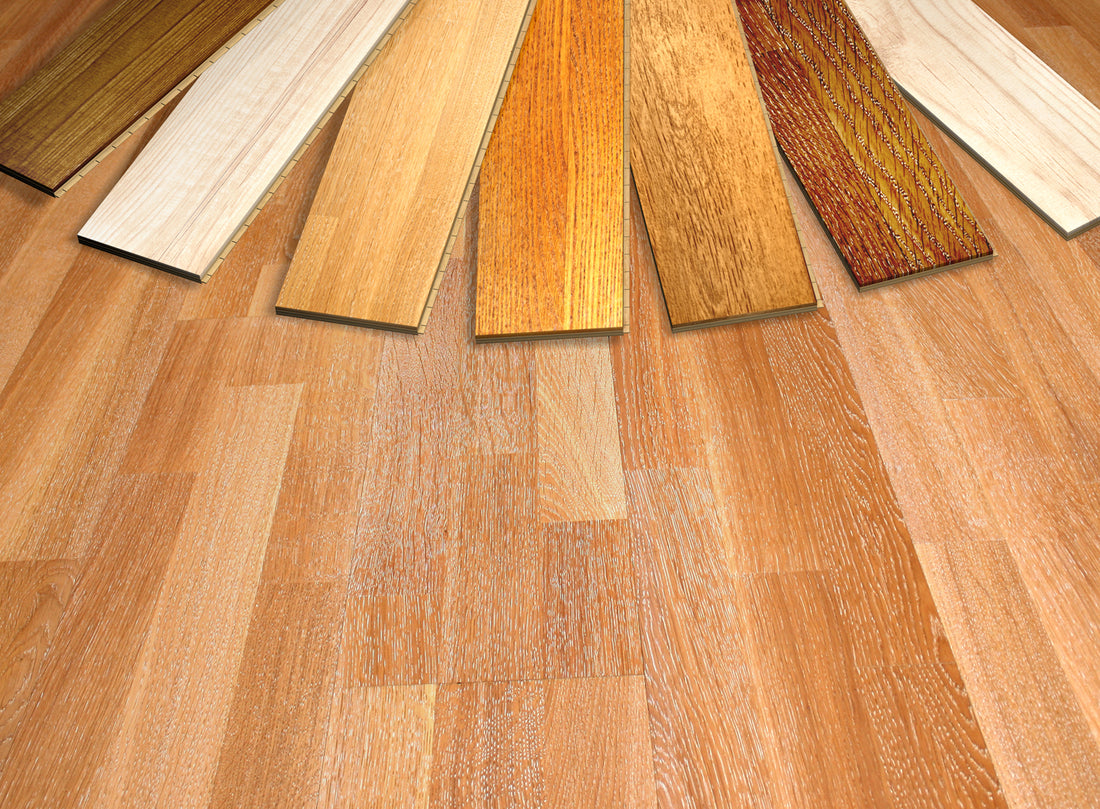Hardwood flooring is a popular choice for homeowners because of its durability, timeless beauty, and versatility. However, with so many hardwood flooring types available, it can be overwhelming to decide which one to choose. To help you find the best hardwood flooring for your home, we've put together a list of our top recommendations.
Types of Hardwood Flooring

1. White Oak Hardwood Floor
White oak is a popular choice for hardwood flooring because of its durability and resistance to wear and tear. It has a pale, yellow-brown colour with a pronounced grain pattern, giving it a natural, rustic appearance. White oak also has a high level of tannins, making it resistant to water and insect damage. It's an excellent choice for homes with children and pets due to its durability.
2. Maple Hardwood Floor
Maple hardwood flooring is a versatile option that looks great in a wide range of home styles, from contemporary to traditional. It has a light, creamy colour that gives a clean, modern look to any space. Maple is also one of the hardest hardwoods, making it an excellent choice for high-traffic areas.
3. Hickory Hardwood Floor
Hickory is a highly durable hardwood flooring option that is resistant to scratches and dents. It has a distinctive grain pattern with colour variations that range from light to dark brown, giving it a rustic appearance. It's an excellent choice for homes with pets and children due to its durability and resistance to damage.
4. Brazilian Cherry Hardwood Floor
Brazilian Cherry hardwood flooring is an exotic option that will give your home a rich, luxurious look. It has a tight, swirling grain pattern with shades of rich red-brown, making it a bold and beautiful choice for any space. Brazilian Cherry is highly durable and resistant to scratches and dents. Be aware of moisture (particularly dry environments) as certain regions of North America are not good for exotic hardwoods. If it is too dry the hardwood floor surface will crack.
5. Walnut Hardwood Floor
Walnut hardwood flooring is a classic option that will never go out of style. It has a dark, rich colour with a straight-grain pattern, giving it a timeless and elegant appearance. American Walnut is softer than most other hardwoods, so it is more appropriate for 'adult living' and low-traffic areas.
There are several excellent options when it comes to hardwood flooring. Each type offers unique benefits and can help create a different look and feel in your home. Whether you choose rugged hickory or elegant walnut, be sure to work with a professional installer who can help you choose the perfect hardwood flooring for your home.
Tips for Choosing the Best Hardwood Floors

A hardwood floor is a classic addition to any room. You can create a modern oasis or a traditional home base with hardwood floors, regardless of the decor style you choose. Hardwood floors are a personal choice, so the best hardwood floors are dependent on you!
1. Your Preferred Hardwood Floor Design
While it would be ideal to have a hardwood flooring solution that fits everyone, it is important to remember that each individual has different design preferences and needs. Nevertheless, we have plenty of tips to assist you in choosing the perfect floors for you, your family, your pets, and even your favorite activities. The choice of the right wood flooring goes far beyond the colour. While colour is important, it is equally important to finding flooring that is durable enough for your space as well as within your budget. Grades... understanding hardwood flooring grades are a key part of the decision process. The hardwood species and colour of the stain are top visual factors, but grade of hardwood will influence the visual look and the cost of the hardwood floor. See section below called ' Hardwood Flooring Grades'.
2. The Foot Traffic Of The Room
The first step in selecting hardwood flooring is to determine the room in which it will be installed. It is important to consider this factor as the amount of wear and tear your floor experiences can often vary from room to room. The amount of spills and foot traffic that occurs in the kitchen, for example, is far greater than in the master bedroom. Consequently, the location may affect the type of durability you require for hardwood floors.
3. Consider Your Budget For Hardwood Flooring
Your budget is also an important consideration since some wood types are more expensive than others. Ebony is one of the most expensive species of wood due to its combination of rareness and durability, as well as its resistance to termites. In contrast, wood-look laminates and luxury vinyl planks are inexpensive ways to achieve the hardwood look you desire.
Aside from different types of wood, there are many different products and methods for finishing floors. Some wood planks are prefinished from the factory, whereas others need to be finished after they are installed. There is a difference in price between each type of flooring and finish.
4. Choosing Your Preferred Colour Of Hardwood Floor
Last but not least, how your floors will look is a key consideration. Among the many wood species, the most common ones include hickory, oak, cherry, ash, maple, ebony, and bamboo. Among these species, there are subspecies that vary in colour and have distinct grain patterns. The colour of cherry, for example, is a distinctively warm red, whereas that of white oak is light and contains white accents. If you want to select the right wood species and colour for your room, you must have a vision of what you want it to look like.
Additionally, it is important to keep in mind that wood changes over time. Over time, wood can expand and contract due to seasonal changes, and sunlight can also change the colour of the wood. Keeping your hardwood floors in good condition may require regular maintenance and refinishing.
Hardwood Flooring Grades
In North America, hardwood flooring is generally graded based on the National Wood Flooring Association's (NWFA) grading system. The NWFA grading system assigns a grade to each board based on its appearance, with higher grades indicating fewer defects and a more uniform appearance.
White oak is a popular species of hardwood flooring and is typically available in three common grades: Select, #1 Common, and #2 Common.
Select Grade: This is the highest grade of hardwood flooring and will have the most uniform appearance. Select grade white oak will have very few knots and color variations. The boards will have a consistent color and grain pattern.
#1 Common Grade: This grade is also known as "character grade" or "rustic grade." #1 Common grade white oak will have more color variations and knots than select grade. The knots are generally smaller and less frequent than #2 Common grade. (see below paragraph describing #1 Common vs #1 Common and Better).
#2 Common Grade: This grade is also known as "utility grade" or "cabin grade." #2 Common grade white oak will have more knots and color variations than #1 Common. The knots in this grade can be larger and more frequent.
The size and amount of knots allowed in each grade of hardwood flooring are specified by the NWFA grading rules. In general, knots are allowed in #1 Common and #2 Common grades, but not in Select grades. The size and frequency of knots will vary based on the grade.
In #1 Common grade, knots are limited to 1-1/2 inches in diameter and can occur up to 8 times per 3-foot board. In #2 Common grade, knots can be up to 2-1/2 inches in diameter and occur more frequently, with up to 20 knots per 3-foot board.
It's important to note that the appearance of knots can vary based on the cut of the wood. Quarter-sawn boards will have smaller and more uniform knots than plain-sawn boards.
Overall, buyers of white oak hardwood flooring can expect to see fewer and smaller knots in higher grades, with more knots and color variations in lower grades.
Another Grade? Common #1 vs Common #1 and Better
#1 Common and #1 Common and Better are two different grades of hardwood flooring that are often used interchangeably, but there is a difference between them.
#1 Common grade is also known as "character grade" or "rustic grade." This grade of hardwood flooring has more knots, mineral streaks, and color variations than higher grades. Knots in #1 Common grade can be up to 1-1/2 inches in diameter, and there can be up to 8 knots per 3-foot board.
#1 Common and Better grade, on the other hand, is a step up from #1 Common grade. It has similar characteristics to #1 Common grade, but with fewer and smaller knots, mineral streaks, and color variations. Knots in #1 Common and Better grade can be up to 1 inch in diameter, and there can be up to 5 knots per 3-foot board.
The "Better" designation means that the grade is a selection of boards that are hand-selected from #1 Common grade for their better-than-average appearance. This means that #1 Common and Better grade boards will generally have a more uniform appearance than #1 Common grade boards.
It's important to note that hardwood flooring grades can vary between manufacturers, so it's always a good idea to check with your specific supplier to understand their grading system and what to expect from the hardwood flooring you are purchasing.
Wait, Then What is ABCD Grade in Hardwood mean? I am So Confused!
We get asked to explain why some flooring sellers describe their grades as AB, ABC or ABCD and other sellers use terms like Select, #1 Common, Common #1 and Better, etc.
There are a few reasons why some flooring sellers use different grading systems and terms to describe their hardwood flooring grades. Here are some explanations:
Historical reasons: Different grading systems and terms have been used for hardwood flooring for many years, and some manufacturers and sellers have stuck with the traditional systems and terms they have always used. For example, the NWFA grading system that uses terms like Select, #1 Common, and #2 Common has been in use since the 1950s, and some manufacturers and sellers continue to use it because it is familiar and well-established.
Regional variations: Some grading systems and terms may be more common in certain regions of the country. For example, the AB, ABC, ABCD grading system is more commonly used in the West Coast, while the NWFA grading system is more commonly used in the East Coast and Midwest. This may be due to historical preferences or differences in the types of hardwood species that are available in each region. It is possible that due to the trade route of Asian made products, they are moist commonly shipped to the West Coast of North America, and therefore, that could be the reason that West Coast Flooring sellers use the terms AB, ABC, ABCD flooring grades to describe their hardwood flooring grades. the other reason for the East Coast flooring seller using the official NWFA grade names is likely influenced by the fact hat hardwood is grown and manufactured in Ontario and Quebec, so they are closer to he mills that use the proper NWFA grading designations.
Marketing reasons: Some sellers may use different grading systems and terms as a way to differentiate their products or appeal to different customers. For example, a seller who uses the AB, ABC, ABCD system may be targeting customers who are looking for a more rustic or natural-looking hardwood floor, while a seller who uses the NWFA system may be targeting customers who are looking for a more uniform and consistent appearance.
It's important to note that regardless of the grading system or terms used, it's always a good idea to ask the seller for specific information about the characteristics of the hardwood flooring you are considering, such as the size and frequency of knots, mineral streaks, and other natural variations in the wood. This can help you make an informed decision and ensure that you are getting the hardwood flooring that meets your specific needs and preferences.
What Are The Benefits Of Hardwood Flooring?

Hardwood flooring is one of the most popular flooring options available today and for good reason. This type of flooring is known for its durability and longevity, which makes it a great investment for any homeowner. Unlike carpeting or other types of flooring, hardwood floors can last for decades with proper care and maintenance. They also offer a classic, timeless look that never goes out of style, which can increase the value of your home.
Hardwood flooring is also easy to clean and maintain, which is perfect for busy households or those with pets and children. This type of flooring is resistant to stains and odors, as well as scratches and dents, which means it can withstand heavy foot traffic and wear and tear. Additionally, hardwood flooring is versatile and can be refinished in a variety of colours and stains to match any decor style. This level of customization ensures that your flooring will always look great and add value to your home.
Other benefits of hardwood flooring include improved indoor air quality, as it doesn't trap dust, dander, or other allergens like carpeting can. It also helps to make rooms feel larger and more spacious due to its natural, warm colours and patterns. Overall, hardwood flooring is a smart investment that can enhance the beauty and functionality of any home.
Other flooring blog articles you may want to read:
What Are The Benefits of Vinyl Flooring?
Laminate, Vinyl, and Engineered Hardwood Flooring Options: What Makes Them Different?
